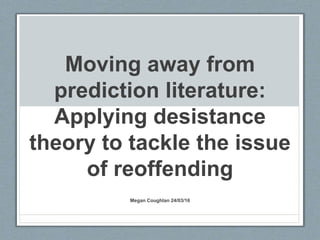
Criminology Conference Presentation
- 1. Moving away from prediction literature: Applying desistance theory to tackle the issue of reoffending Megan Coughlan 24/03/16
- 2. Outline • Three stages in offending process • Reoffending statistics and research • One reoffending theory • Three categories of desistance theories • Application of desistance theories to reoffending
- 3. Three stages in offending Farrington (2015) • Beginning • Career length • End Theories • Onset • Reoffending • Desistance
- 4. Onset Theories Example of theories • Strain theory (Agnew, 2005) • Subculture theory (Cohen, 1995) • General theory of crime (Gottfredson & Hirschi, 1990) Limitations • Emphasis on universality ignores the complexity and changeability of human behaviour • Cannot take into account the individual and his/her surrounding context • SPOOCS: “Past criminality does not necessarily determine offending levels in the early 20s, and new factors emerge to help alter old patterns of behaviour”
- 5. Definitions Reoffending • Nagin et al (2009): • Reoffending refers to “all criminal acts committed by a person.” • Reoffending researchers do not assume that offending will be constant throughout the life course but occur at a high level compared to other offenders Desistance • Bottoms et al. (2004): • Desistance refers to “any significant lull or crime-free gap in the course of a criminal career.”
- 6. Irish Reoffending Statistics • CSO (2015): recidivism rate of 47.5% within three years • Reoffending most likely in first 12 months of release • Only 6 studies on reoffending conducted in Republic of Ireland.
- 7. Irish reoffending research Reimprisonment Reconviction Hart (1974) ✔ Probation Service (2007, 2008) ✔ ✔ O’Donnell et al. (2008) ✔ Prison Service (2013) ✔ CSO (2015) ✔
- 8. Quantitative reoffending research Andrews and Bonta (2010) • Criminal history • Antisocial personality pattern • Social support for crime • Pro-criminal attitudes • Substance abuse • Family relationships • School/employment • Lack of pro-social recreational activities Cambridge study Farrington (2003) • Age of onset • Childhood risk factors • Poor parenting skills • Low school attainment • Father criminality • Risk taking behaviour
- 9. Reoffending Theories Zamble and Quinsey (1997) • Coping hypothesis – inability to cope along with negative emotions increases the likelihood of reoffending. Limitations • At present there is only one reoffending theory • It is primarily psychologically focused and therefore does not afford factors such as social support the same importance.
- 10. Desistance theories Three categories: • Social Control • Psychological • Integrative
- 11. Desistance Theories Social control theory • Laub and Sampson (2003) • Theory: Desistance occurs through forming pro-social bonds that re-orientate an individual towards conventional society and away from offending. Contribution to reoffending • Lengthy incarcerations • Unstable living arrangements • Lack of steady employment • Never married or divorced
- 12. Desistance theory Identity theory • Maruna (2001) • Redemption Script: “making good” • One establishes their “true identity.” • Becomes optimistic about their future • Desire to give something back to society. Contribution to reoffending • Condemnation script: “doomed to deviance” • Self-defence mechanism • Lack of hope • Lack of self-efficacy
- 13. Desistance theories Cognitive transformations • Giordano et al. (2002): “hooks for change” already existing in the environment must be actively chosen by an individual. Contribution to reoffending • High level of disadvantage • Social marginalisation • Cognitive openness to reoffending • Very small gender differences.
- 14. Integrative approach • LeBel et al. (2008) determine that the complex interaction between agency and environment key to understanding the process of offending • Farrall & Bowling (1999) attest to the importance of including both social and subjective factors in any explanation of offending.
- 15. Summary contribution to reoffending Factors • Lengthy incarcerations • Unstable living arrangements • Lack of steady employment • Never married or divorced • High disadvantage • Social marginalisation • Doomed to deviance • Cognitive openness reoffending Concepts • No social support • No agency
- 16. Two key concepts: social support and agency Desistance literature: • Pro-social support: for example, marriage or employment can exert control over an individuals behaviour encouraging desistance. • Agency: for example, Maruna (2001): refers to four main themes of self- mastery, status or victory, achievement or responsibility and empowerment, encouraging desistance. Generalising concepts • Social support: these can be pro-social or anti-social depending on the individual and stage of offending. • Agency: Paternoster & Pogarsky (2009; 111): “an intentional activity directed towards some goal.”
- 17. Applying these concepts to reoffending • Both concepts are used in desistance research and are therefore defined pro-socially. • Therefore, desistance research argues that reoffenders are the opposite to desisters. • But what if the two groups are not opposites?
- 18. Current research • Parallel mixed methods approach to investigate self- reported reoffending • Laub and Sampson (2003): official records for their participants showed 62% of offenders had desisted, in actual reality self-report data revealed that only 11% had desisted from crime. • Examine social support and agency to see how they are uniquely utilised at the reoffending stage • Identify other factors relevant to reoffending • Explore gender differences
- 19. Conclusion • Integrative theoretical framework is the strongest approach in desistance research and will therefore be applied to further knowledge about reoffending. • Desistance theories appear inaccurate in their claim that reoffenders lack key concepts such as social support and agency. • It would appear that reoffenders do have both social support and agency but utilise them differently. • Key questions: What factors, influences and intentions are relevant in the reoffending stage? And are they uniquely utilised in this stage?